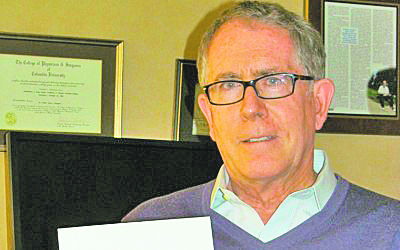This week I had plans to do a piece on the aesthetics of figure skating.
So early Sunday morning I headed down to Iceland which is considered a local institution at 3345 Hillside Ave. in New Hyde Park with camera and pad in hand.
I was planning to explore the question of whether the coaches thought figure skating was more art or sport.
As I pulled into the parking lot I could see it was already filled and thought to myself that there must be lots of figure skaters on Long Island. But the closer I got to the front door the more I realized that this was hockey time.
There is an old joke that says “I went to a boxing match last night and a hockey game broke out.”
My new joke is “I went to a figure skating competition last night and the competitors had helmets and pads on!”
Get ready to be introduced to the secret world of premier youth hockey.
On this morning the U16 Ice Cats of the Long Island Amateur Hockey League were going up against the Nassau County Lions.
And the first thing I noticed as I chatted with the players on the sidelines was how expensive the equipment looked.
The goalie told me that his pads cost $450; helmet cost $500, skates $600 and stick $200. That’s almost $2,000 before you hit the ice. This is a serious hobby.
I have met Sarah Hughes of Olympic figure skating fame and know that her ‘hobby cost her family over $100,000 per year. For many years.
Chris Loche is one of the Ice Cats coaches and he told me that most his players are headed for competitive NCAA or club play after high school and that on this level they all have great athleticism, agility, strength and on ice awareness. That means they all have very high hockey IQ’s.
When the game finally got under way I could see that words like athleticism and agility do not do them justice.
At this level I immediately saw that these kids are very fast and very fearless. The sound of skates on ice and bodies hitting boards was shocking.
I can only imagine what the bruises look like after a game. Yet they all keep coming back four to five times a week for practice or for games.
And even at 8 a.m. on a Sunday morning the stands were filled with parents in warm coats and hats, under blankets and sipping hot chocolate between cheers.
I took a few photos and before my fingers froze up completely, said my goodbyes and left.
As I walked through the parking lot I looked more carefully at the cars that were there. They were mostly high end SUV’s like Lexus or Mercedes and all with private school high school stickers.
These were parents that were willing to invest in their kid’s education and their sports life. I thought back at my own childhood and how lucky I was to have parents who were willing and able to take me to the country club every day all summer long where I was able to develop my skills and prepare for college golf.
Not once did they question how many chits I spent or how much money I cost them each month.
As a sport psychologist many of my patients are elite young athletes whose parents regularly spend $30,000 to $40,000 per year on their child’s sport.
I usually ask them if the investment is worth all that money and they invariably tell me the same thing, “If they weren’t putting all their spare time and energy into their sport what do you think they would be doing? Getting into trouble is my guess.”
And that is only one of the benefits of a serious amateur sports career. The chance to develop real athletic ability is a rare and special thing. It is not too much to say that there is something transcendent and transforming about excelling at something. It is a joy to do and equally a joy to behold.
Many years ago when I was still in my early 20s and playing lots of good golf my girlfriend who later became my wife said to me “Tom you are lucky to be able to do this one thing so very well.”
I always remember that remark and I think she was right. To be able to perform one thing in either a sport or art to a level of excellence is an extraordinary feeling. It is our way of transcending our humanness and being something a little better. Isn’t that what they call transcendence in religion?
I consider myself to be a social critic or someone who gets paid to worry about the state of affairs in our culture. And there is indeed much to worry about.
I do most of my writing for either magazines or scholarly journals.
But when I have experiences like the one I had on Sunday at Iceland I unquestionably and immediately have more faith in America.
Because what this tells me is that we have many parents who are willing to invest in their kids and many kids who are willing to invest in the pursuit of excellence.
And this is a very, very good thing.



